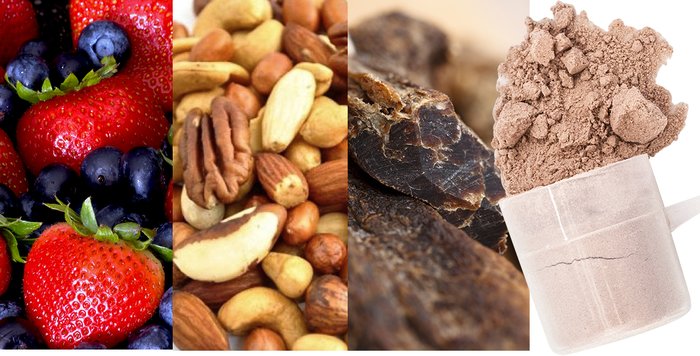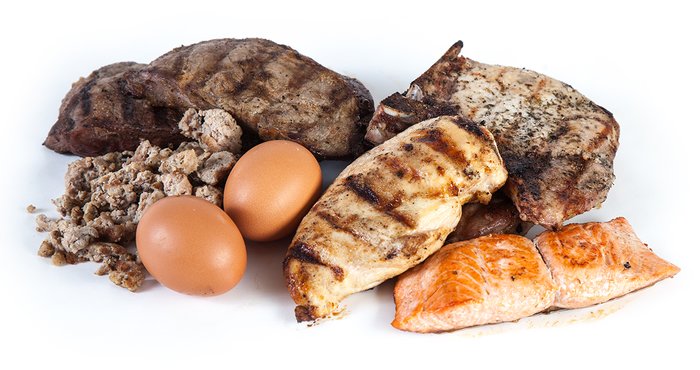Often, getting lean is treated like a frantic undertaking rather than the daily norm. In a panicked rush, diets get cleaned up and training intensity, volume, and frequency go ballistic. For many people, this is an annual routine. But 10-year NFL veteran Steve Weatherford is proof positive that it doesn't have to be.
Looking at his physique, you'd think he'd been a fitness model who moonlighted as a pro punter, but it was really the other way around—until now. With more time to feed his body and train the way he's always wanted to, this new retiree is bigger and leaner than ever. At 6-foot-2 and 230 pounds, Steve's body fat hovers at 5-6 percent year-round.
How does he do it? Live-in, professional chefs, perhaps? An MTV Cribs-worthy home gym setup? Hardly. For Steve—and anyone else—ditching unwanted body fat and keeping it away is a question of being consistent with these few key habits.
1. Rep Out on the Classics
There's a time and a place to go heavy, and Steve knows it. In the NFL, he did his time with barbell power cleans, big benches, and soul-crushing squats. Sure, they'll all help build muscle, But to look as strong as you are, Steve also swears by incorporating old-school bodyweight moves done for plenty of reps.
"Some of my favorite workouts have just been bodyweight," he says. "Push-ups, sit-ups, pull-ups, lunges, bodyweight squats—there are a million different ways to work different muscle groups to failure. Just because you hit failure at, say, 30 reps doesn't mean it's any less effective!"
The science backs him up. While it's somewhat obvious that high reps can produce a serious caloric burn, they can also help you add or keep muscle. A 2014 study compared the effects of training at 25-35 reps versus training with 6-8 reps. Both groups took their sets to failure. Surprisingly, both groups gained the same amount of lean muscle, even though the heavier training group gained more strength. So the lesson for you: Do your push-ups, but do them until you can't do any more!
2. Prep Meals for the Times You'll Need Them
Eating clean can seem like no big mystery when you've got plenty of time on your hands. Steve doesn't. Each weekend, he takes a look at the week to come, spots the moments he's pretty sure he's not covered nutritionally, and then does the work to fill the gaps.
"It's all about planning," he says. "Sunday nights for me, I usually spend about two hours with my wife cooking. I cook 16 chicken breasts, 2 pounds of brown rice, and cook up a bunch of vegetables. I put it all in Tupperware and throw them in the fridge. And if I know I'm gonna be gone for three days, I take a cooler pack with me on the plane and have my meals for three days. It's quick, it's easy, and it'll work for you, too."
Car commuter rather than train? Pack your car, desk, and home with good stuff to crush cravings and fuel your body right. Having whole fruit, nuts, beef jerky, protein powder, and other easy-to-tote foods within reach wherever you are makes it a lot easier to meet a lofty nutritional goal.

3. Time Your Cheat Meal With a Certain Workout
For hard-training, clean-eating individuals, there may be nothing more rewarding or cathartic than getting lost in the occasional cheat meal. When done right, this calculated indulgence can actually be advantageous.
"For me, there's no workout that is more intense or more demanding than my leg workout," Steve says. "So for me, my go-to post-workout meal is going to be a meat lover's pizza, or for my West Coast people, an In-N-Out burger with four patties, no cheese, and don't be afraid of the bread. I don't worry about my calories or carbs when I'm having those intense training sessions."
That's because he knows where all that meaty goodness is going. After a hard workout, your muscles are ultrareceptive to the nutrients you throw at them—fast-digesting carbs create a desirable spike of insulin that helps your muscles replenish glycogen faster and proteins are assimilated more readily by broken-down muscle fibers. But cheat meals also have another important benefit: They maintain your sanity when you're at your most run-down.
So first, earn it. But once you have, enjoy it.
4. Turn Your Workout on Its Head
If your biggest obstacle to getting lean is your bland or repetitive diet, why would you let your workout routine fall to the same fate? Steve says keeping things fresh is key to staying lean 365 days a year.
"For me, it's not necessarily changing the way I'm training, or even the particular exercises, but I like to change the rep ranges and the amount of volume I'm doing," he says. "If I'm trying to increase strength or muscle density, I may do 4 sets of 5 reps for a few weeks, then for two weeks, I'll focus on size and do 4 sets of 10 reps. To keep from plateauing, it's essential to train your muscles at different volumes."
If you're looking for another way to spice things up, kick traditional machine-based cardio to the curb. You can get the same physical effects with none of the monotony by heading out for a trail ride on a bike, taking a boxing class, or playing flag football with friends. Lift hard, and do cardio for fun. What an idea!
5. Supp for Growth and Recovery, Not Fat Loss
Quick: what's the best supplement you can take for fat-loss? If you said a fat burner, you're still thinking in that "get lean" mindset rather than the "be lean" mindset.
Steve's stack is a simple one that's all about maximizing health, workout performance, and recovery, in that order. Hit those three priorities, and leanness is a lot easier to maintain.
"I eat about eight egg whites for breakfast every day and take my multivitamin at that time," he says. "Then I take my Pre on my way to the gym, which has everything I need to fuel my training. I work out for 80-90 minutes, then take a blend of fast-acting whey protein and slow-release casein, which feeds my muscles for hours after my workout. Finally, it's True Grit Post, which has the ideal ratio of amino acids to kick-start growth. Those are the basics of an effective, efficient supplement stack. You don't need any more than that."
6. Keep Protein the Priority
You don't have to count every single calorie and micronutrient to look great. But protein consumption is the bedrock of any formidable physique, and it will pay off big time if you know yours and keep it dialed in.
"I've had great results by always getting at least a gram of protein for every gram of lean mass on my body," Steve says. "I'm around 220 pounds and about 5-6 percent body fat, so I want to get at least 210 grams of protein each day. When I'm trying to add muscle, I dial it up even higher, as high as 300-310 grams a day."

This prescription may sound familiar, but very few people actually achieve it on a daily basis. Track your protein intake for a few days to get an honest assessment of how much you're getting, and adjust accordingly. Come what may, make hitting your number a priority.
7. Be Selfish
With a finite number of hours in the day, it can be difficult to justify the time it takes to prep food, commute to the gym, train, stretch, and do everything else it takes to reach your desired level of lean. Steve's solution: Get it done early, and get it done for the right reason.
"I get it," he says. "We all have lives, jobs, families, and responsibilities. But on the other hand, finding the time to get into the gym helps me handle all those things better. The only thing I can recommend is to be selfish; take that time to get into the gym and eliminate all distractions, put on your head phones, put on your playlist, and motor through a workout."
Sure, you want to sleep more. Who doesn't? But here's Steve's answer: "There's nothing better than getting up early and investing in myself. If I do that, I can be the best me for everybody else in my life." There's no arguing with that—especially if it means you also get to live ripped year round!
References
- Schoenfeld, B. J., Ratamess, N. A., Peterson, M. D., Contreras, B., Sonmez, G. T., & Alvar, B. A. (2014). Effects of different volume-equated resistance training loading strategies on muscular adaptations in well-trained men. The Journal of Strength & Conditioning Research, 28(10), 2909-2918.

